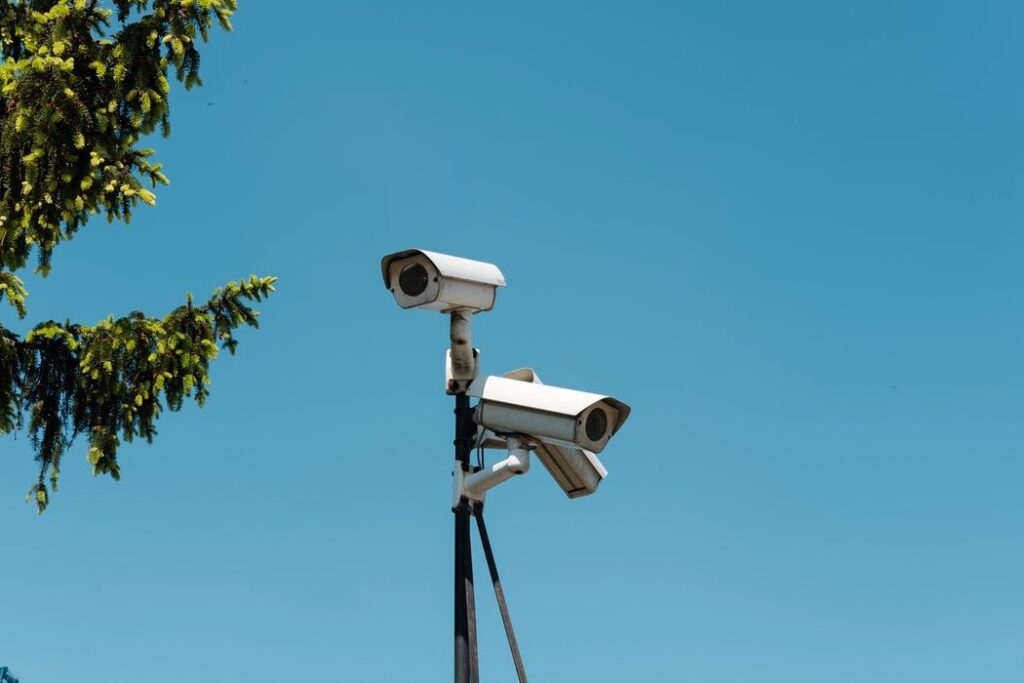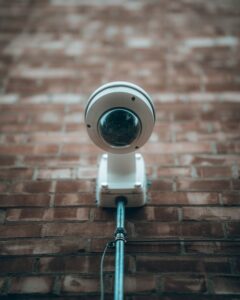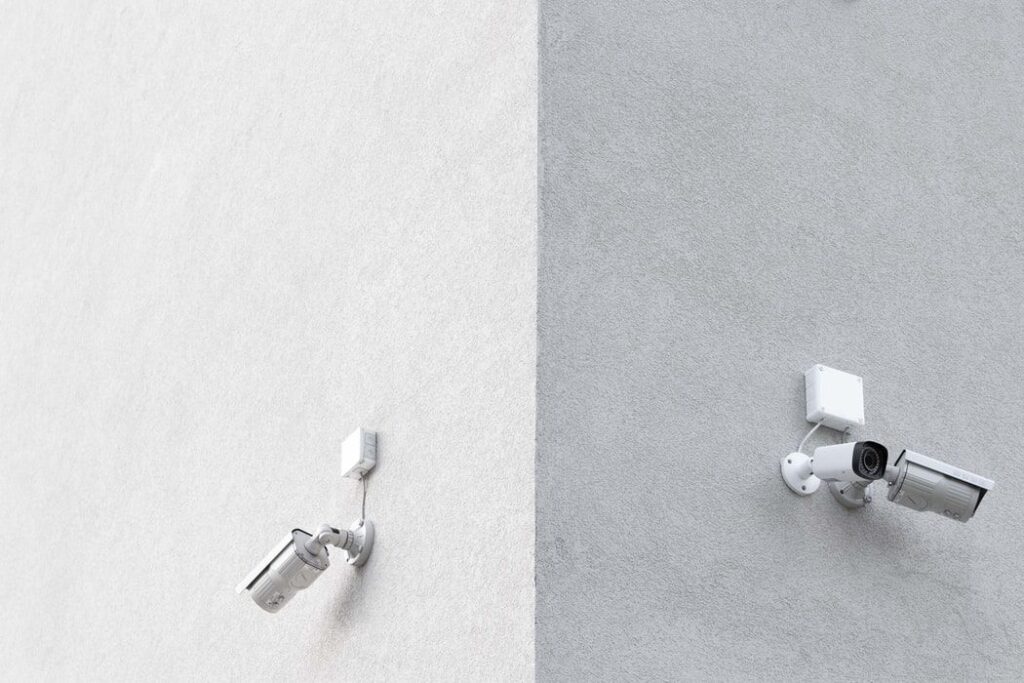What Is CCTV
To monitor the launch of V2 rockets, German scientists invented CCTV technology in 1942. American scientists later employed it as part of the atomic bomb testing. Furthermore, CCTV has changed drastically since its development in 1942. Whereas once upon a time, it is only used to watch live footage, it rapidly evolved into a recording system that enabled users to see and save data. As a result, it became the ultimate security technology.

What is CCTV
CCTV is an acronym for Closed-Circuit Television. It is a closed circuit because the signal is not freely transmitted as it is with broadcast television. The footage from the video cameras sends it back to a series of monitors.
In CCTV, the television is a video camera that functions as a communications medium, transmitting moving pictures to surveillance monitors. In general, CCTV is a video surveillance system that strategically placed cameras to record video images and send them to a display or monitors with only a limited number of individuals accessing it.
CCTV Camera Types
Dome Camera
Dome Cameras are for indoor security systems. The dome shape of these cameras makes them inconspicuous because it is difficult to determine which way they are facing while yet being visible to the naked eye. They are a common sight in retail spaces to monitor a wider angle.
Bullet Camera
Bullet Cameras feature a cylinder-like shape that mimics an enormous ammunition cartridge and is long and tapered. Furthermore, bullet cameras are for long-distance surveillance. Also, they are outdoors weatherproof surveillance and are prevalent in manufacturing, farming, and property management industries.
C-Mount Camera
C-Mount Cameras use demountable lenses for different purposes. For fine-tune focal distance, it uses a varifocal lens. They are for achieving variable zoom in and out without losing their focus. C-Mount Cameras are popular in the utilities and logistics industries.
Day/Night CCTV Camera
Day/Night CCTV Cameras are for 24/7 surveillance. These surveillance cameras, mainly used outside, offer a broad dynamic range and can work in direct sunshine, glare, or reflections. They are therefore ideal for businesses that require round-the-clock CCTV monitoring.
HD (High Definition) CCTV Camera
HD CCTV Cameras are for highly niche places, such as casinos and banks. These surveillance cameras are comparatively at a higher resolution than others. Therefore, they can capture finer details when zooming in without losing their quality.
PTZ (Pan Tilt Zoom) Camera
PTZ Cameras allows the operator to pan, tilt, and zoom the lens freely. The operator can program or manually control them to follow an accurate view. Furthermore, these expensive cameras are for achieving responsiveness. They are popular in large retail environments.
Network/IP CCTV Camera
Network/IP CCTV Cameras can transfer recordings over the internet with or without a wire connection. They can send recordings over a far distance without the power boost required. However, they are easy to install in comparison to an analog camera.
Infrared/Night Vision CCTV Camera
Infrared/Night Vision CCTV Cameras can see what is happening in absolute darkness. They can also capture images even in the presence of dust, smoke, or fog. An infrared cut filter activates for clear photos.
Wireless CCTV Camera
Wireless CCTV Cameras work on wireless technology. Furthermore, they are easier to install and have a discreet appearance and less obtrusive fitting. The transmission of the footage is via the internet for convenient access.
CCTV Applications
Security, monitoring, and surveillance are the primary functions of CCTV systems. Listed below are some of the CCTV applications:
Crime Management
CCTV surveillance cameras can deter potential criminals. When a crime occurs, video footage can aid law enforcement in the investigation and subsequently serve as evidence in a court of law. When used in conjunction with CCTV, thermal, audio, and other sensors can alert officials of unusual events, such as gunshots or fire at a place.
However, CCTV cameras in businesses can identify and track in-house illegal activity. Video monitoring may be used in prisons to prevent drones from carrying narcotics and other contraband to inmates. Security cameras can also monitor locations that are difficult to access, such as rooftops.
Home Security
Burglaries and vandalism are considerably less probable in homes with security camera surveillance than those without security cameras. Although security cameras do little to prevent crime physically, homeowners are increasingly using them to dissuade trespassers and keep their families secure.
Business Surveillance
Businesses use CCT technology for a variety of purposes, including as a crime deterrent. Because most companies have cash on hand, banks, offices, museums, restaurants, retail stores, and other enterprises are hotbeds for a crime. Therefore, security cameras are carefully placed at registers, back offices, near safes, and entrances to secure the money. However, to deter theft and vandalism, retail establishments install security cameras on the sales floors.
In addition, businesses utilize security cameras to monitor employees and ensure that they are making the most out of their time. It is beneficial when a company employs night workers, such as cleaning and maintenance crews, call center employees, and inventory management teams.
Disaster Management
Emergency services and rescue workers can analyze and monitor occurrences in real-time using CCTV cameras and then rely on disaster management teams through videos, such as a burning building, a cave, or a helicopter hovering over a scene.
City and Community Street Monitoring
Cameras monitor people at traffic signals and other locations around cities to collect traffic data and evidence of speeding. Security cameras are among the sensory nodes that evaluate the images they capture but do not broadcast or store them to preserve privacy. In most cases, just a limited number are kept for senior academics to utilize to “create computer vision software.” Furthermore, privacy advocates have raised concerns about the initiative.
Medical Monitoring and Diagnosis
There are around 43 facial muscles that allow humans to communicate their ideas and feelings. Innovative software can more readily detect certain emotions, such as pain or fear, in photographs than individuals can. Patients – such as youngsters or the elderly – can also be monitored by CCTV cameras to detect possible medical catastrophes, such as a stroke, asthma attack, or epileptic.
Retail Intelligence
Market intelligence gleaned from video surveillance of consumers is used to evaluate trends and enable enhanced strategizing, such as how people shop, etc. However, heat maps may assist retailers in determining peak purchasing hours, preferred promotion kinds, and staffing requirements during peak shopping periods by displaying the highs and lows of consumer activity at specific places in the store.
Behavioral Research
According to CCTV footage used in suicide studies, 83 percent of those attempting to jump in front of a train displayed particular behaviors. These were analyzed subsequently using CCTV footage and are now used to warn monitor watchers of suspected suicides. However, researchers also utilize surveillance networks to track crowd activity in public locations and prevent anti-social conduct. Schools, for example, have employed cameras for security and record bullying and playground events on video.
CCTV Systems and How Do They Work
Analog Security Systems
Analog surveillance systems use transmission wires to link a typical analog camera to a digital video recorder (DVR). The DVR collects footage from the camera, compresses it, and saves it to a hard disk for live or later viewing. Furthermore, this setup also enables you to stream the movie over the internet for watching from afar.
With the analog system, the DVR compresses, converts, stores, and streams the video. It is also in charge of all the camera’s built-in features, such as motion detection, alerts, schedules, alarm inputs, and so on.
Pros: Easier installation and cheaper
Cons: No data encryption, lower resolution, and more cabling required
IP Security Systems
IP systems are a little more complicated and, as a result, more costly. The camera takes over the DVR’s responsibilities in an IP setup, such as compressing, transcoding, and streaming footage over the internet.
Pros: Enable the automation of surveillance process and highly mobile, enable remote monitoring, and no network cabling required
Cons: Expensive, at risk from hackers, and entails a higher learning curve.
Types of Systems Available
There are a lot of different CCTV systems accessible to the public, but each falls under one of the following three categories:
Simple CCTV Systems
It consists of a single coax cable connecting a camera (or cameras) to a display or monitors. The monitor in simple system powers the cameras.
Mains Powered CCTV Systems
It works in the same way as a simple system, except that mains powers separately both monitor and camera. However, this setup provides more scalability because it is easy to add additional cameras to the system without running out of power.
Systems with Recording Capabilities
It includes video recorders for data preservation and the opportunity to review footage at a later time. Furthermore, you can add a DVR to this system for video retrieval and additional storage or transmission.

Key CCTV Tech Terms
Video Encoders
Video encoders allow analog CCTV systems to be converted to network systems, allowing users to use lower-cost hardware and contemporary functionality. The program enables a wired connection before digitizing and transmitting video data to a wired or wireless IP-based system.
Image Sensors
Different types of image sensors are used in cameras to transform light into electrical signals. Multiple photodiodes, or pixels, make up a sensor that detects the quantity of light exposed and converts it to electrons. The two popular formats are CMOS and CCD.
CMOS (Complementary Metal Oxide Semiconductor)
CMOS sensors are cheaper than CCD sensors. Megapixel (millions of pixels) CMOS sensors may even outperform CCD sensors in terms of quality.
CCD (Charged Coupled Device)
These consume more electricity and are more expensive. CCD scanners are typically the best choice for low-light situations (greater light sensitivity) and are quieter than CMOS scanners. (Although the transmission is analog, it is transformed to numeric values for information by an analog-to-digital converter.)
Image Scanning
CCD sensors typically employ an interlaced scanning method (immediate exposure) for digital CCTV, but CMOS and CCD can use either interlaced or progressive scanning. Furthermore, interlaced scanning is the sole scanning method used by analog cameras.
Interlaced (famous for CCD applications)
The transmission of odd and even TVLs (L stands for lines) from an image is the goal of this technique. Cameras with more than 400 lines have a fair resolution, while those with more than 700 lines have high resolution. Furthermore, these signals are updated regularly, lowering bandwidth and deceiving the human brain into believing it is viewing a single, complete image.
As long as an interlaced recording is viewed on an interlaced display, an interlaced image on a progressive scan monitor may seem jagged. However, modern video software deinterlaces interlaced scans before converting them to progressive scans viewed on analog and progressive scan monitors.
Progressive (famous for CMOS applications)
This technique does not divide the images into fields (even and odd lines). Instead, scans the image, and each line is shown consecutively on a monitor.
Recorders
DVRs (digital video recorders) are generally part of a CCTV system, connecting to internal components rather than external networks. DVR associates with analog cameras. Furthermore, every camera in a DVR system must be linked directly to the recorder.
While DVR systems process footage on their own, NVR systems process and encode data at the camera level before streaming to a recorder for storage and remote viewing. However, NVR systems use IP cameras. Each IP camera in an NVR system connects to the same network.
Why Use CCTV Technology
The video surveillance sector has sprung up due to CCTV technology, which has enabled a variety of safety options for property owners, police enforcement, and company owners worldwide. The industry has evolved to changing customer demands, delivering better goods with more excellent performance and dependability. Furthermore, CCTV has proved to be one of the most accessible loss prevention and safety monitoring technologies available on the market today, with systems available in all price ranges and each giving varying degrees of protection.
Here in Southwest Integrated Solution, we can conduct a site survey to advise on the correct type of CCTV cameras for your businesses and conform with CCTV regulations. Contact us at (632) 322-5088 and speak to our CCTV experts today!

